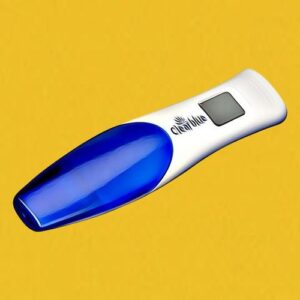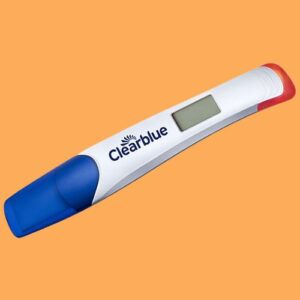Pee Sticks Begone! The World’s First Saliva Pregnancy Test Has Arrived
Forget peeing on sticks, the world’s first saliva-based pregnancy test has launched in the UK, promising easier and more hygienic at-home detection.
British company Abingdon Health has launched the revolutionary ‘Salistick’ test, now available in the UK at Superdrug stores and online for £9.99. It marks the first major innovation in over-the-counter pregnancy testing in decades. But just how does it work and what are the benefits over traditional kits? Let’s take a look at how pregnancy testing has evolved over time and whether this new development really is a gamechanger.
A Brief History of Pregnancy Testing
While today’s familiar pee-on-a-stick kits only emerged in the 1970s, detection methods using urine date right back to Ancient Egypt. Papyrus medical documents from 1350 BCE describe how urine was poured onto wheat and barley seeds, with the type of grain that grew indicating the baby’s gender.
This reliance on urine continued for centuries, with its colour, smells and ability to ferment used as crude indicators of pregnancy. It wasn’t until the early 20th century that doctors realised these changes were caused by hormones like human chorionic gonadotropin (hCG).
In the 1920s, scientists started developing the first urine tests to detect hCG. These initial versions involved injecting samples into animals like toads and rabbits to see if they ovulated, signalling pregnancy. By the 1950s, immunological tests were emerging that reacted to the presence of the hormone on a slide.
Home kits as we know them today arrived in the 1970s. They work by detecting hCG in a urine sample through antibodies that bind to the hormone and trigger a colour change. The trademark ‘blue line’ first emerged with e.p.t.’s test in 1988, providing an unambiguous positive or negative result.
Despite small improvements like digital displays, the testing process has remained largely unchanged over the past 40 years. Women still have to pee on a stick and wait several minutes for the result.
How the New Saliva Test Works
Salistick promises to overhaul the testing experience through one simple change – ditching urine for saliva.
To use it, you pool saliva in your mouth, insert the collection stick and wait for an indicator to change colour when enough spit is gathered. This is then slotted into the test unit, where it mixes with a buffer solution and flows across a test strip.
Results appear within 5 to 15 minutes, potentially as fast as 3 minutes.
The key is that hormones like hCG are present in saliva, as well as urine. This means it can detect pregnancy just as accurately. The test has a claimed 97% accuracy from 2 days after a missed period when used properly.
Abingdon Health developed it using their proprietary lateral flow technology and extensive experience with rapid diagnostic tests. Clinical studies showed Salistick performed on par with leading urine-based kits.
4 Benefits of Saliva Testing
This shift from pee to spit brings several advantages:
1. Easier Sample Collection
No more faffing around with collection cups! Saliva is quick and straightforward to gather, with the test stick doing all the work. There’s no mess, spillage or accidental hand contamination.
2. Use Anywhere, Anytime
Waiting until you next need the loo to take a test could be a thing of the past. Saliva can be easily collected wherever you are, at any time of day.
3. No Need to Abstain from Drinking
To use urine kits, women are typically advised to limit fluid intake for several hours beforehand. This concentrates the sample and avoids diluting any hCG present. With the new saliva version, there’s no need to go thirsty while waiting to test.
4. Shared Experience
The clean, hands-off collection may help take the test out of the bathroom. Partners can be present and part of the process, rather than waiting outside. Using it could become a shared moment, whether the result is positive or negative.
Of course, saliva testing isn’t perfect. The need to avoid eating and drinking for around 30 minutes beforehand could be a downside. But it undoubtedly offers a leap forward in convenience and hygiene.
Over 50 Years Since the First Home Kit
It’s remarkable to think the world’s first do-it-yourself pregnancy test only appeared in 1968. Made by a company called Organon, EarlyPregnancyTest worked much like today’s kits, detecting hCG in urine.
Within a few years, competitors started launching their own versions and by the 1980s pregnancy testing had moved firmly into the mainstream. Those early plastic devices offered women privacy and control, letting them find out if they were expecting in the comfort of their own home.
But the core technology remained largely stagnant. This first saliva test marks the biggest shakeup since those very first home kits in the late 60s. While a minor tweak, switching bodily fluids could make the vital process of self-testing simpler, more refined and ultimately more empowering.
The Next 50 Years
So what might the next half a century hold for pregnancy testing?
For a start, accuracy will likely continue to improve, especially for early detection. Results in 1 minute or less could become standard, aided by improved pregnancy detection science. Testing could also explode beyond home use, becoming available in all kinds of public facilities.
Non-invasive prenatal testing (NIPT) that requires only a blood sample is already transforming pregnancy screening for conditions like Down’s syndrome. In the future, such technology may integrate with home testing to offer a detailed rundown of pregnancy health from the outset.
At its core though, self-testing offers something clinical procedures cannot – privacy and personal control over one of life’s most intimate moments. So while technology will continue advancing, it’s likely home kits will remain the first choice for women looking to take a pregnancy test discreetly.
With its arrival, Salistick marks a small but pivotal step in that journey – and the changing face of pregnancy testing.
Photo by Jonathan Borba on Unsplash
Zoom Baby is a leading supplier of Pregnancy Tests and Ovulation Test Kits





